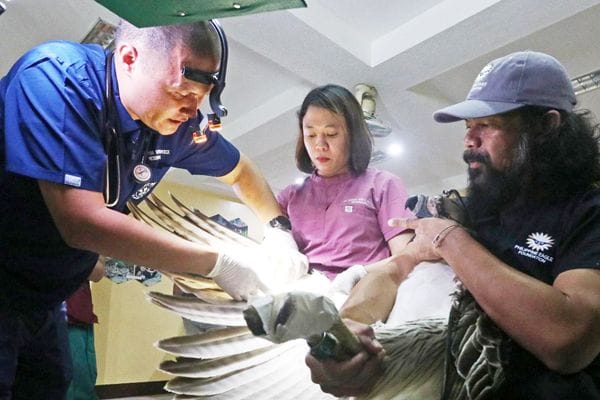Volunteers keep Philippine Eagle Foundation afloat

Source: Manila Bulletin
DAVAO CITY - Volunteers are the lifeline of many non-profit groups that operate with limited resources.
Among them is the Philippine Eagle Foundation that relies on grants and donations to sustain its conservation efforts to keep the national bird, the Philippine Eagle, away from extinction.
Dr. Jayson Ibañez, PEF director for operations, said that volunteers have been instrumental in all aspects of conservation efforts to save the critically-endangered Philippine Eagle.
Saying that nature work in the non-government organization sector is mostly labor of love, Ibañez emphasized that the volunteers are like lifelines amid the limited resources of the foundation.
"Volunteers contributing their talents and skills for free helps a lot. Secondly, conservation is everybody's concern. Providing a platform for people from all walks of life, from elderly to youth and the kids, means conservation is democratized," he said.
DR. Bayani Vandenbroeck checks an injured Philippine Eagle in Davao City. (Keith Bacongco)
The seasoned eagle conservationist acknowledged the vital role of volunteers coming from indigenous communities.
Ibañez said that having indigenous peoples as volunteers is a great advantage since the places where eagle and biodiversity are found are their ancestral domains.
"They have place attachment and so they have the motivation to take care of their land if they receive the support they need. In the same way that we protect and take care of our homes and backyard because they are our safe place," he said.
Furthermore, tribes know the wildlife and forests like the back of their hands, the PEF official said. "They are therefore the rightful guardians. Lastly, conservation can also bring a better life for them because it fulfills their obligation to their lands and kin."
Among the key volunteers of PEF is veterinarian Bayani Vandenbroeck who started to help the foundation since he was still a student of the University of the Philippines-Los Baños in Laguna in the early 2000s.
For several years now, Vandenbroeck and his team of veterinarians are providing his services in ensuring the health of raptors and other animals at the Philippine Eagle Center.
He also treats rescued Philippine Eagles from the wild as well as conducting annual check-ups of the raptors.
Most of these rescued eagles had been injured due to bullet wounds from air guns or the customized "jolen guns."
"It's frustrating to keep treating injured eagles. Almost all of the recent rescues have all had injuries sustained from shooting. Sayang because even if we could rehabilitate these birds, some of them are not fit enough for release back into the wild anymore," he said.
Data from the PEF showed that during the pandemic period alone, at least nine eagles have been rescued from the wild. About half of them have been injured due to air gun or jolen guns.
Vandenbroeck said treating an injured Philippine Eagle is different.
Aside from its size, he said, the handling of Philippine Eagles has to be done a lot more carefully. "Added pressure is also the state of the eagle, being the national bird and being a critically endangered species, so we can't really afford to make mistakes and have to be extra careful."
Amid the threats hounding the survival of Philippine Eagles, Vandenbroeck said that reforestation remains as one of the solutions to save the raptors.
"The work we do as veterinarians and the center is small compared to the efforts that are needed to preserve the habitats. Support farmers so they don't need to keep expanding and cutting down forests to make more farms."
According to the PEF, there are about 400 hundred pairs of Philippine Eagles left in the wild.
Mix of volunteers
Currently, several students are at the Philippine Eagle Center in Barangay Malagos here for the annual Philippine Eagle Week celebration from June 4 to 10.
The students, according to the PEF, have volunteered to assist the different activities at the center.
For years, volunteers at the PEF are a mix of different professionals from various fields such as architects, artists, filmmakers, photographers, engineers, and other professionals.
A seasoned lifestyle writer here has been doing volunteer work for the PEF.
Jinggoy Salvador said that he could no longer recall how long he had been a volunteer for the PEF.
A brother of the PEF executive director, Salvador has been organizing different events not just to raise funds for the group but also to raise awareness for the conservation of the national bird.
Salvador cited the ArtFund as one of his contributions in the fund-raising efforts for the foundation.
"When PEF called out for help at the height of the pandemic, ArtFund was set up. The idea was to connect Davao artists, their art with the public, with the Philippine Eagle at the center of the "art dialogue," he recalled.
The fund-raising effort, the seasoned writer said, was able to extend a generous monetary donation to the organization through art.
For filmmaker Raphael Meting, volunteering also gives him an opportunity to share his skills in producing visuals materials that could contribute to the awareness and fund-raising campaign of the foundation.
As a volunteer, Meting admitted that it paved that way for him to spend more time outdoors, especially in the forests. "This is something that I missed when I was a child."
Ibañez said that volunteerism can be a good source of personal well-being. "Contributing to causes beyond a person's personal self-interest develops positive feelings to people and contributes to wellness."
